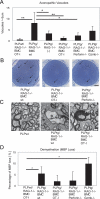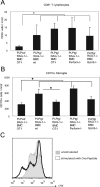Ectopic T-cell specificity and absence of perforin and granzyme B alleviate neural damage in oligodendrocyte mutant mice
- PMID: 20042681
- PMCID: PMC2808063
- DOI: 10.2353/ajpath.2010.090722
Ectopic T-cell specificity and absence of perforin and granzyme B alleviate neural damage in oligodendrocyte mutant mice
Erratum in
- Am J Pathol. 2010 Oct;177(4):2145
Abstract
In transgenic mice overexpressing the major myelin protein of the central nervous system, proteolipid protein, CD8+ T-lymphocytes mediate the primarily genetically caused myelin and axon damage. In the present study, we investigated the cellular and molecular mechanisms underlying this immune-related neural injury. At first, we investigated whether T-cell receptors (TCRs) are involved in these processes. For this purpose, we transferred bone marrow from mutants carrying TCRs with an ectopic specificity to ovalbumin into myelin mutant mice that also lacked normal intrinsic T-cells. T-lymphocytes with ovalbumin-specific TCRs entered the mutant central nervous system to a similar extent as T-lymphocytes from wild-type mice. However, as revealed by histology, electron microscopy and axon- and myelin-related immunocytochemistry, these T-cells did not cause neural damage in the myelin mutants, reflecting the need for specific antigen recognition by cytotoxic CD8+ T-cells. By chimerization with bone marrow from perforin- or granzyme B (Gzmb)-deficient mice, we demonstrated that absence of these cytotoxic molecules resulted in reduced neural damage in myelin mutant mice. Our study strongly suggests that pathogenetically relevant immune reactions in proteolipid protein-overexpressing mice are TCR-dependent and mediated by the classical components of CD8+ T-cell cytotoxicity, perforin, and Gzmb. These findings have high relevance with regard to our understanding of the pathogenesis of disorders primarily caused by genetically mediated oligodendropathy.
Figures



Similar articles
-
Immune cells contribute to myelin degeneration and axonopathic changes in mice overexpressing proteolipid protein in oligodendrocytes.J Neurosci. 2006 Aug 2;26(31):8206-16. doi: 10.1523/JNEUROSCI.1921-06.2006. J Neurosci. 2006. PMID: 16885234 Free PMC article.
-
PD-1 regulates neural damage in oligodendroglia-induced inflammation.PLoS One. 2009;4(2):e4405. doi: 10.1371/journal.pone.0004405. Epub 2009 Feb 6. PLoS One. 2009. PMID: 19197390 Free PMC article.
-
Theiler's virus infection of genetically susceptible mice induces central nervous system-infiltrating CTLs with no apparent viral or major myelin antigenic specificity.J Immunol. 1998 Jun 1;160(11):5661-8. J Immunol. 1998. PMID: 9605173
-
CD8+ T cells and neuronal damage: direct and collateral mechanisms of cytotoxicity and impaired electrical excitability.FASEB J. 2009 Nov;23(11):3659-73. doi: 10.1096/fj.09-136200. Epub 2009 Jun 30. FASEB J. 2009. PMID: 19567369 Review.
-
Perforin: more than just a pore-forming protein.Int Rev Immunol. 2010;29(1):56-76. doi: 10.3109/08830180903349644. Int Rev Immunol. 2010. PMID: 20100082 Review.
Cited by
-
Genetically induced adult oligodendrocyte cell death is associated with poor myelin clearance, reduced remyelination, and axonal damage.J Neurosci. 2011 Jan 19;31(3):1069-80. doi: 10.1523/JNEUROSCI.5035-10.2011. J Neurosci. 2011. PMID: 21248132 Free PMC article.
-
Cytotoxic CNS-associated T cells drive axon degeneration by targeting perturbed oligodendrocytes in PLP1 mutant mice.iScience. 2023 Apr 19;26(5):106698. doi: 10.1016/j.isci.2023.106698. eCollection 2023 May 19. iScience. 2023. PMID: 37182098 Free PMC article.
-
Fingolimod and Teriflunomide Attenuate Neurodegeneration in Mouse Models of Neuronal Ceroid Lipofuscinosis.Mol Ther. 2017 Aug 2;25(8):1889-1899. doi: 10.1016/j.ymthe.2017.04.021. Epub 2017 May 13. Mol Ther. 2017. PMID: 28506594 Free PMC article.
-
Axon-glial interaction in the CNS: what we have learned from mouse models of Pelizaeus-Merzbacher disease.J Anat. 2011 Jul;219(1):33-43. doi: 10.1111/j.1469-7580.2011.01363.x. Epub 2011 Mar 14. J Anat. 2011. PMID: 21401588 Free PMC article. Review.
-
Inflammation's impact on the interaction between oligodendrocytes and axons.Discov Immunol. 2025 Apr 29;4(1):kyaf008. doi: 10.1093/discim/kyaf008. eCollection 2025. Discov Immunol. 2025. PMID: 40636264 Free PMC article. Review.
References
-
- Ip CW, Kroner A, Fischer S, Berghoff M, Kobsar I, Mäurer M, Martini R. Role of immune cells in animal models for inherited peripheral neuropathies. Neuromol Med. 2006;8:175–189. - PubMed
-
- Ip CW, Kroner A, Crocker PR, Nave KA, Martini R. Sialoadhesin deficiency ameliorates myelin degeneration and axonopathic changes in the CNS of PLP overexpressing mice. Neurobiol Dis. 2007;25:105–111. - PubMed
-
- Leder C, Schwab N, Ip CW, Kroner A, Nave KA, Dornmair K, Martini R, Wiendl H. Clonal expansions of pathogenic CD8+ effector cells in the CNS of myelin mutant mice. Mol Cell Neurosci. 2007;36:416–424. - PubMed
-
- Kassmann CM, Lappe-Siefke C, Baes M, Brugger B, Mildner A, Werner HB, Natt O, Michaelis T, Prinz M, Frahm J, Nave KA. Axonal loss and neuroinflammation caused by peroxisome-deficient oligodendrocytes. Nat Genet. 2007;39:969–976. - PubMed
Publication types
MeSH terms
Substances
LinkOut - more resources
Full Text Sources
Molecular Biology Databases
Research Materials

